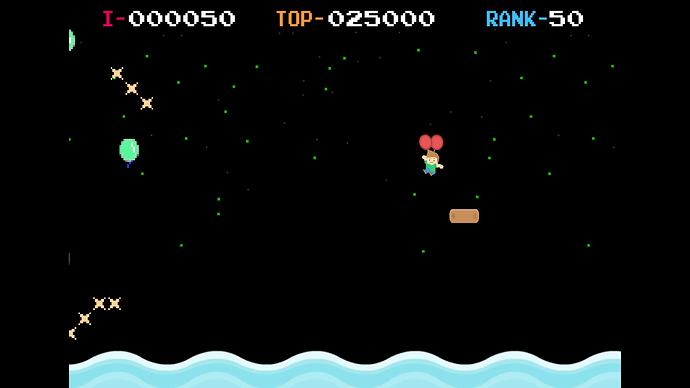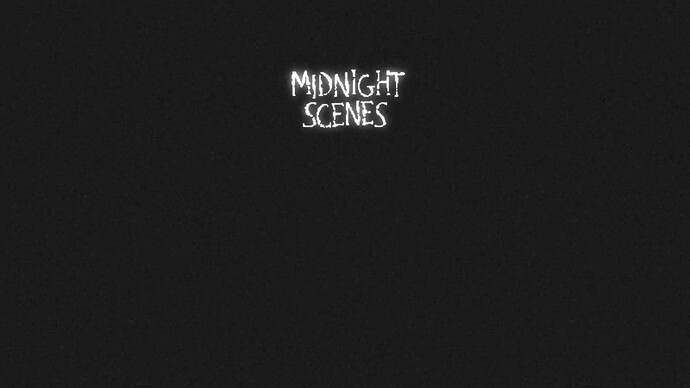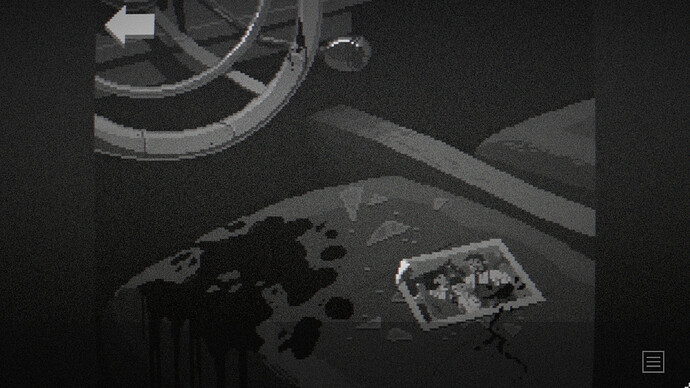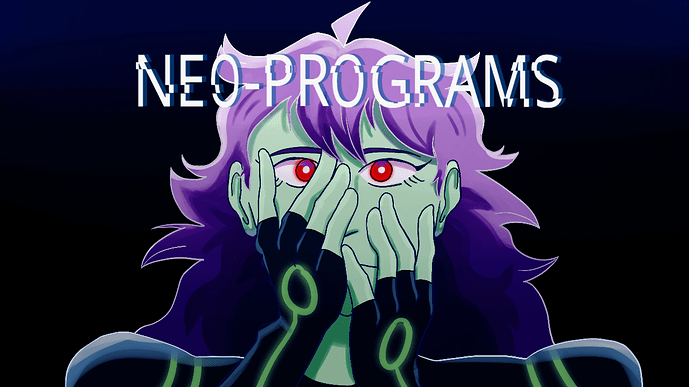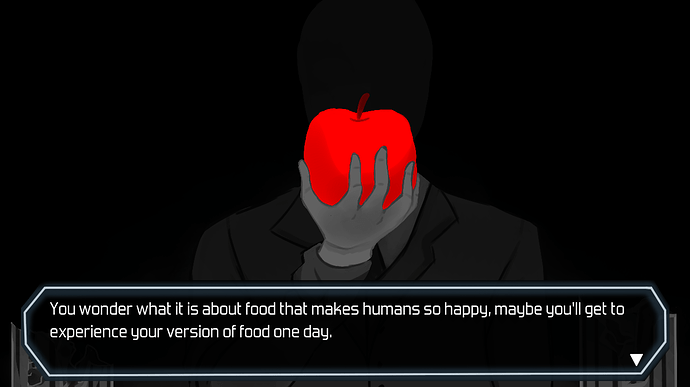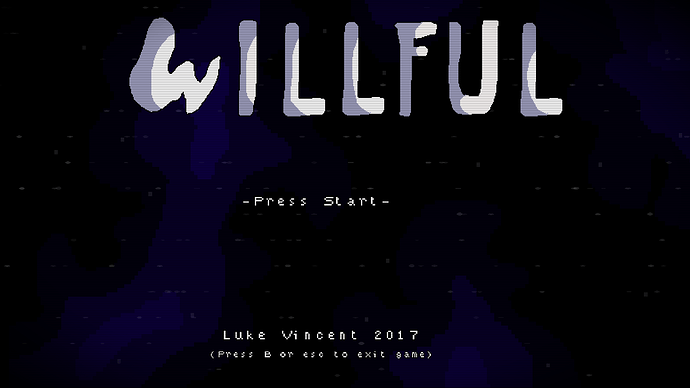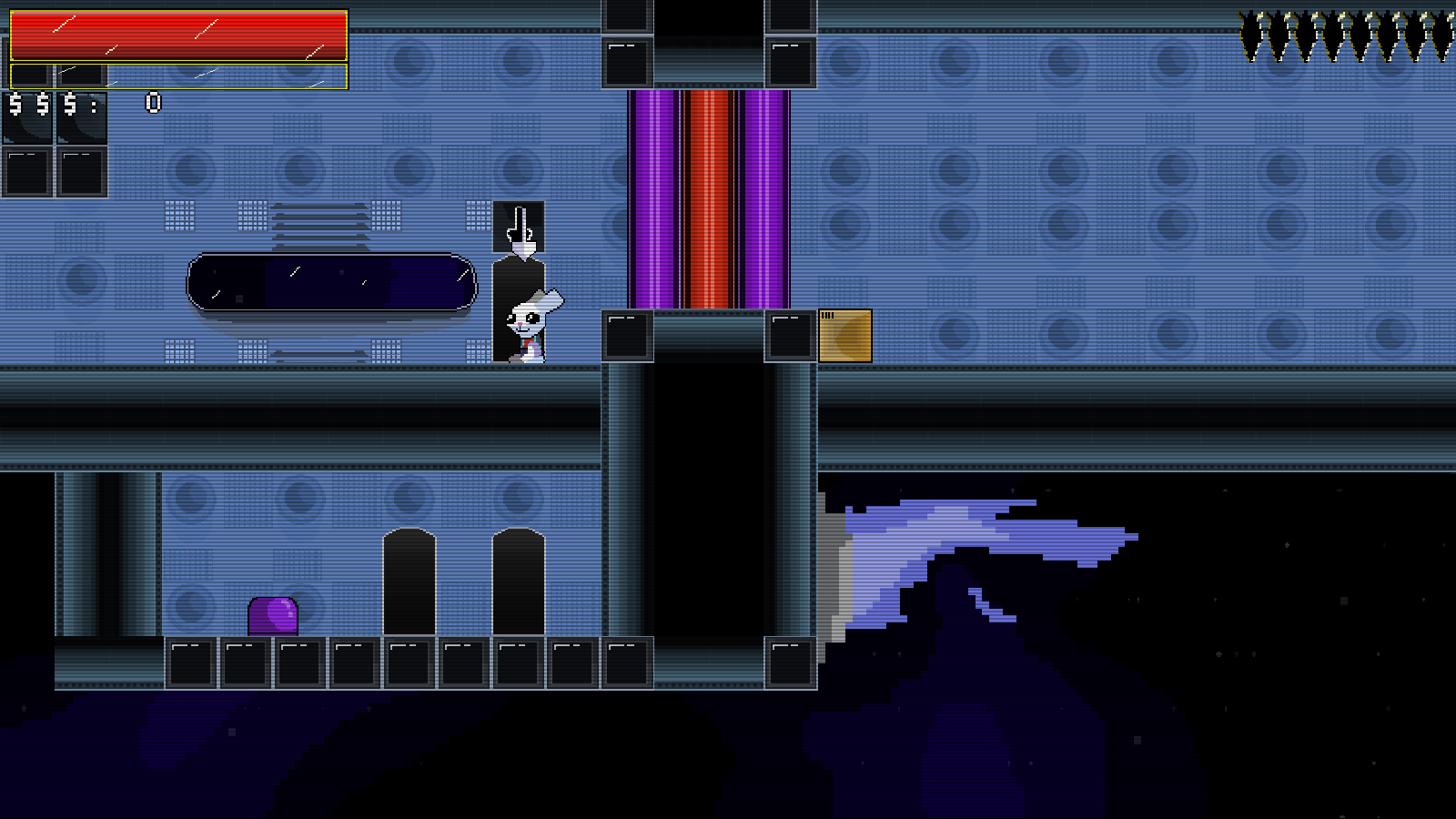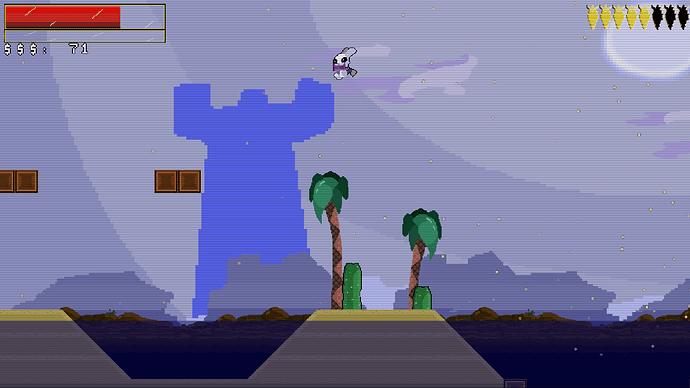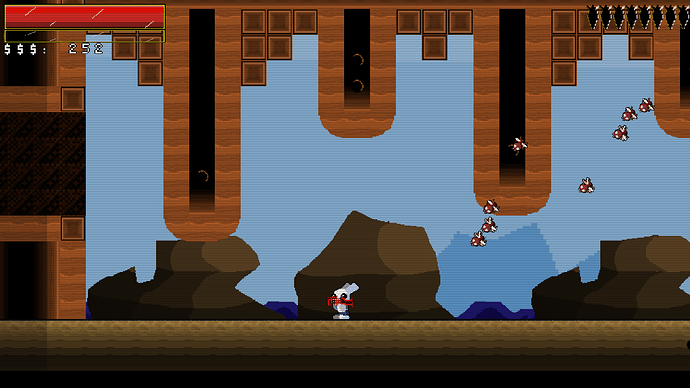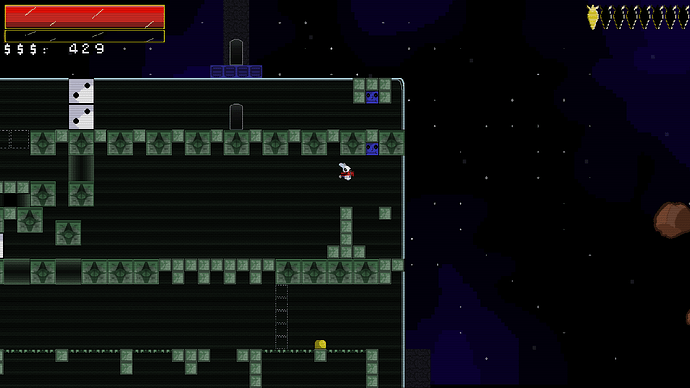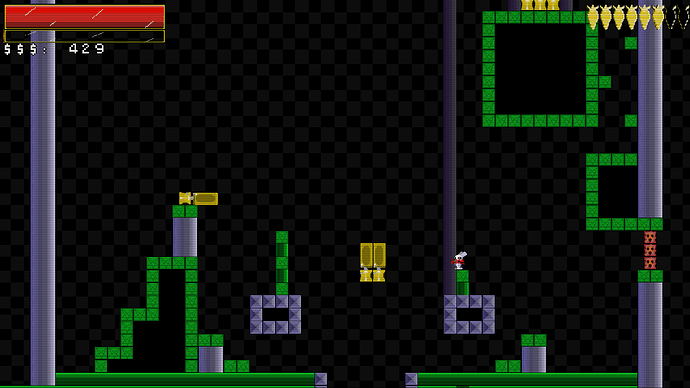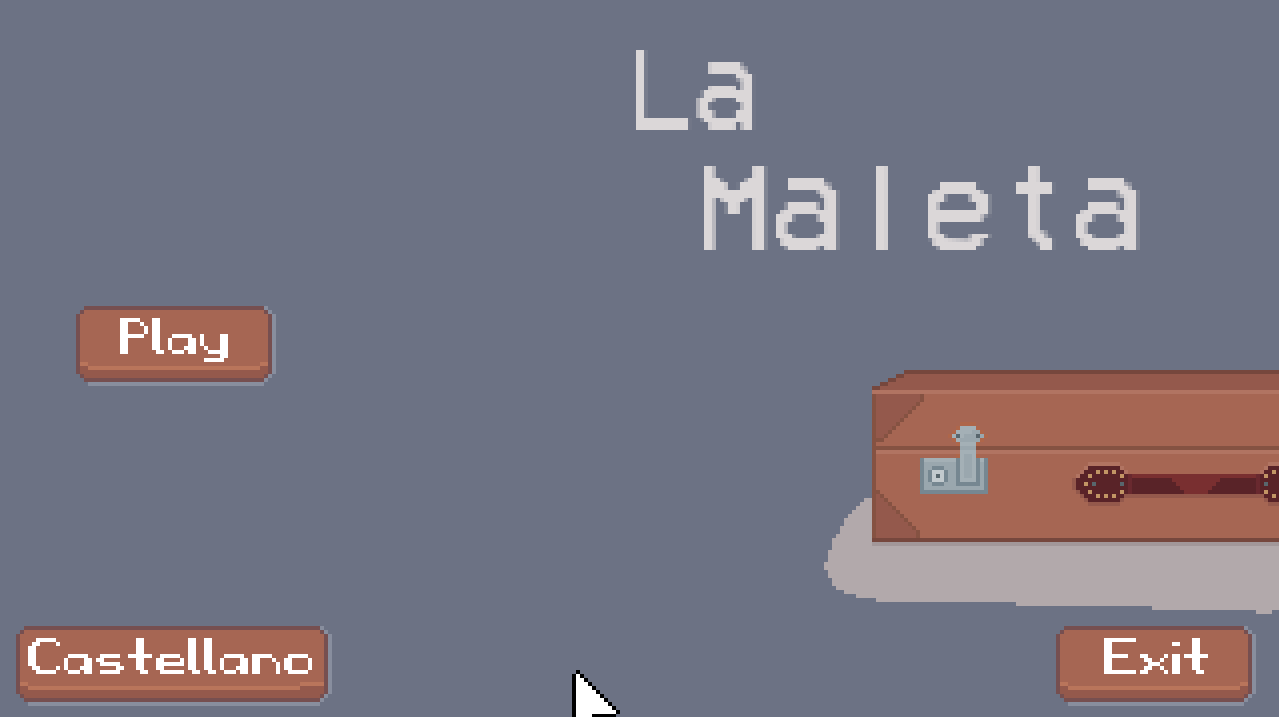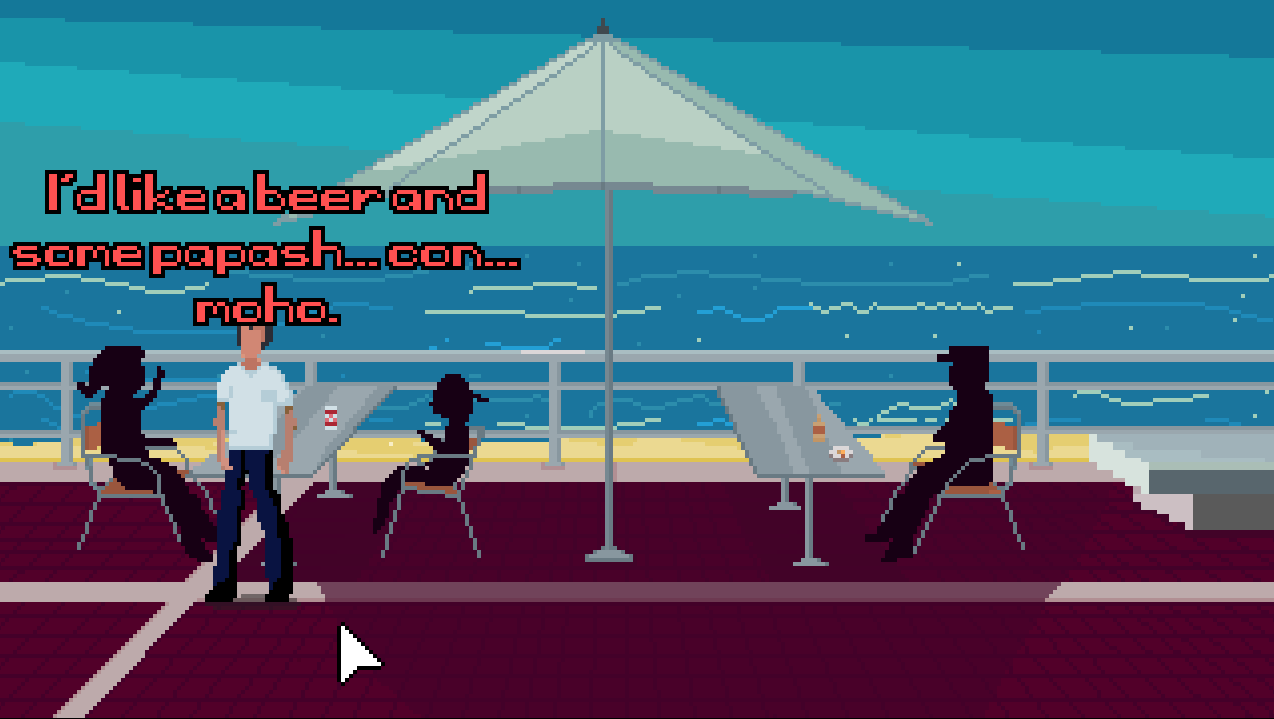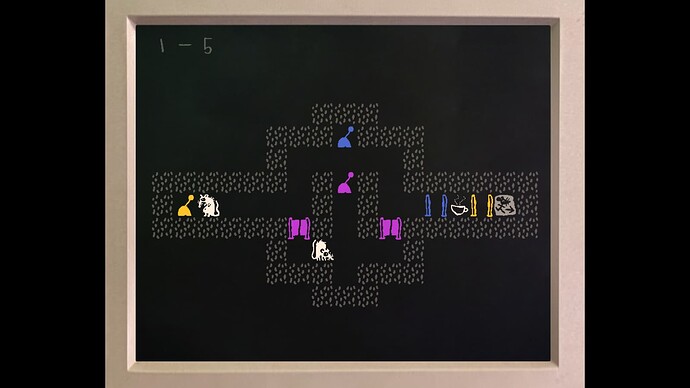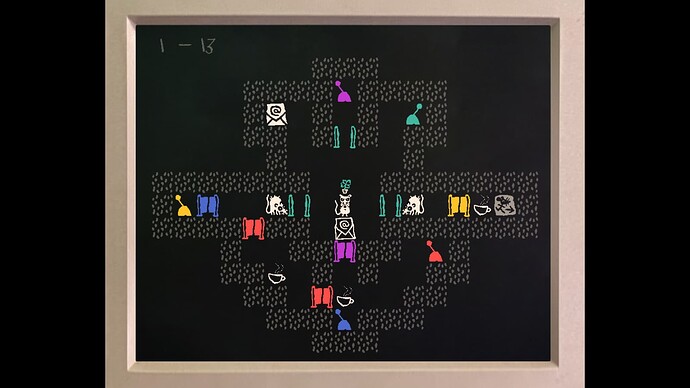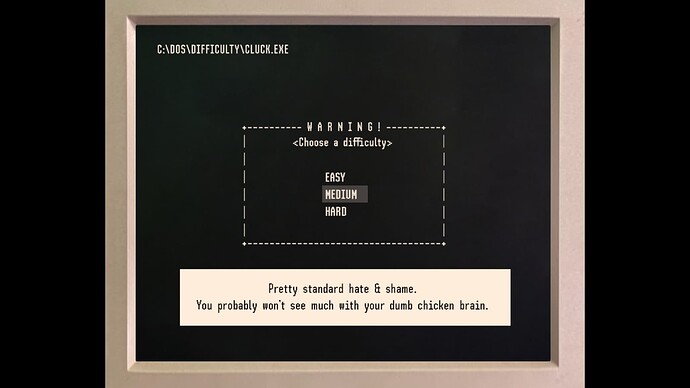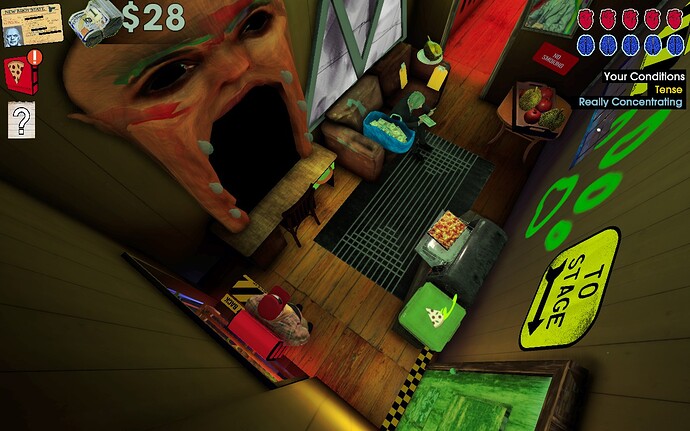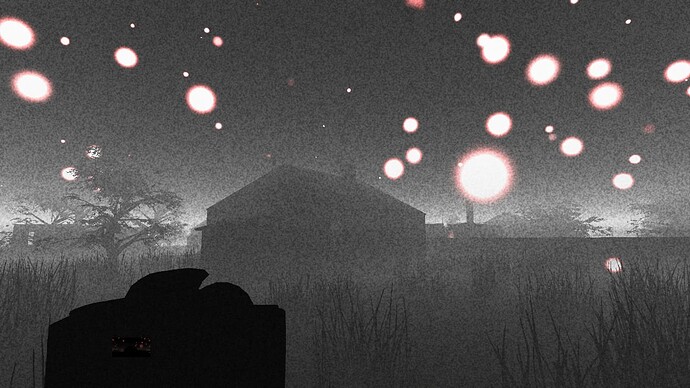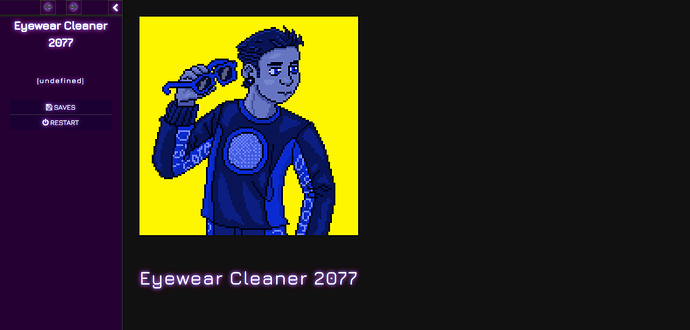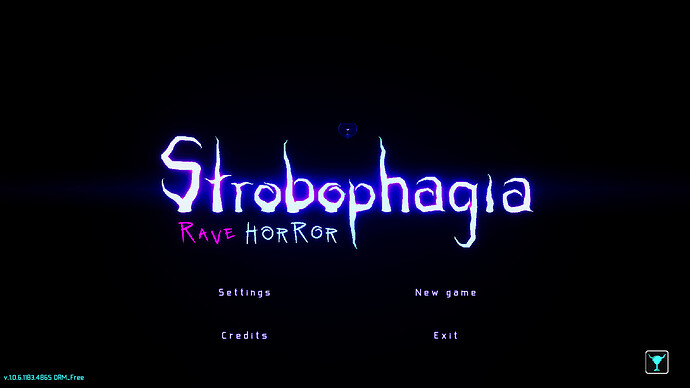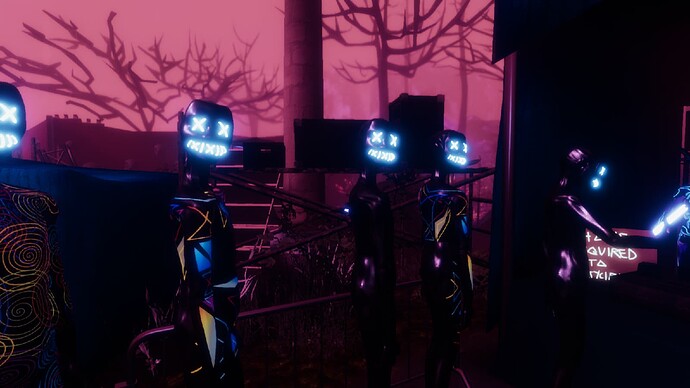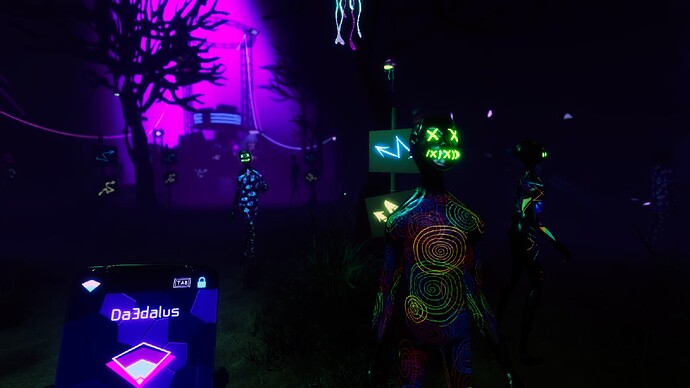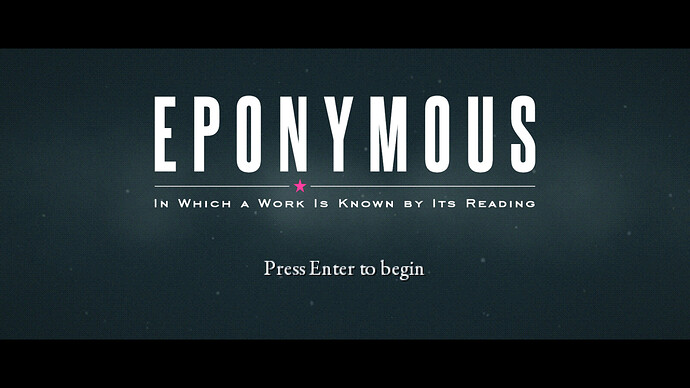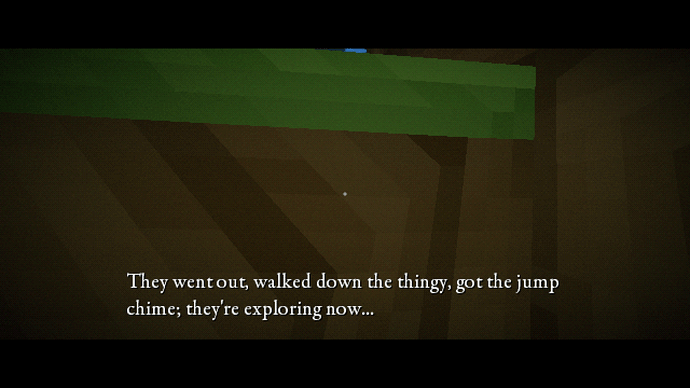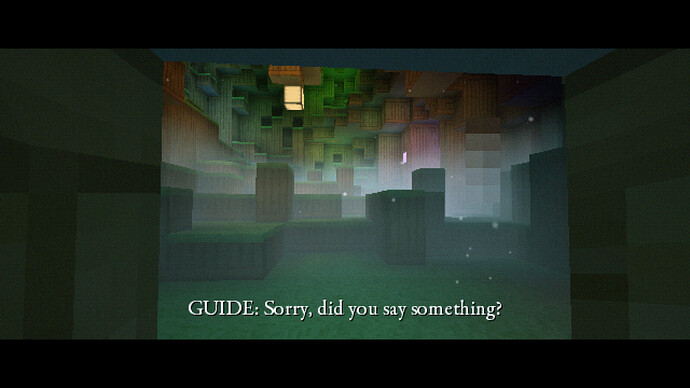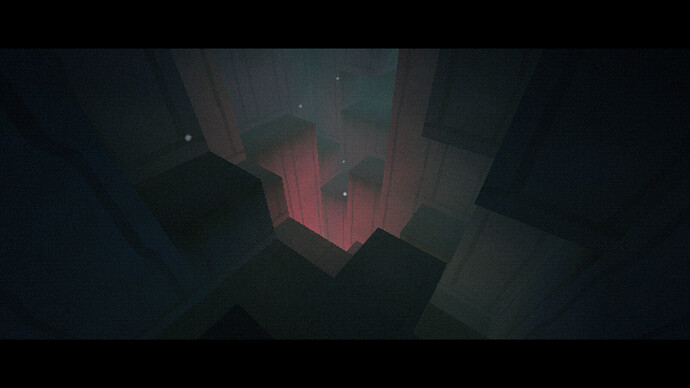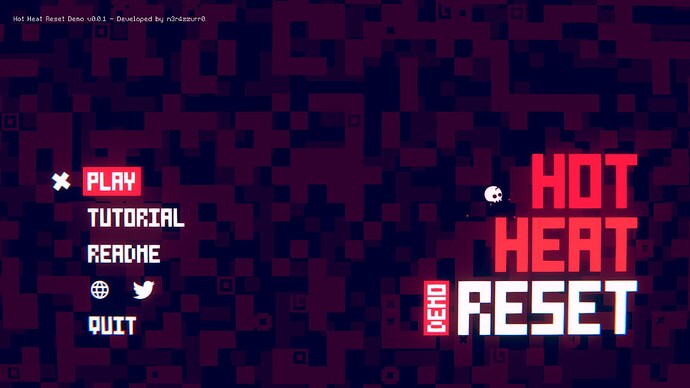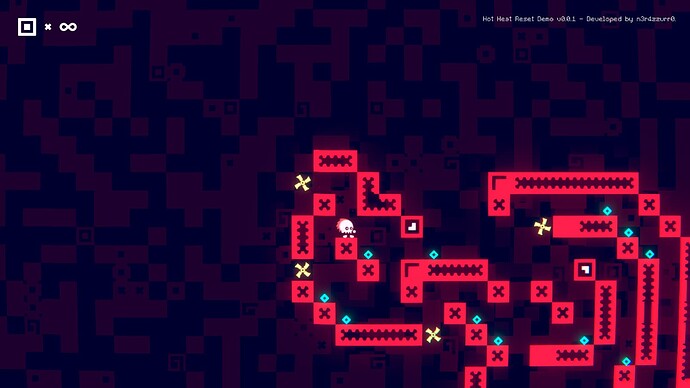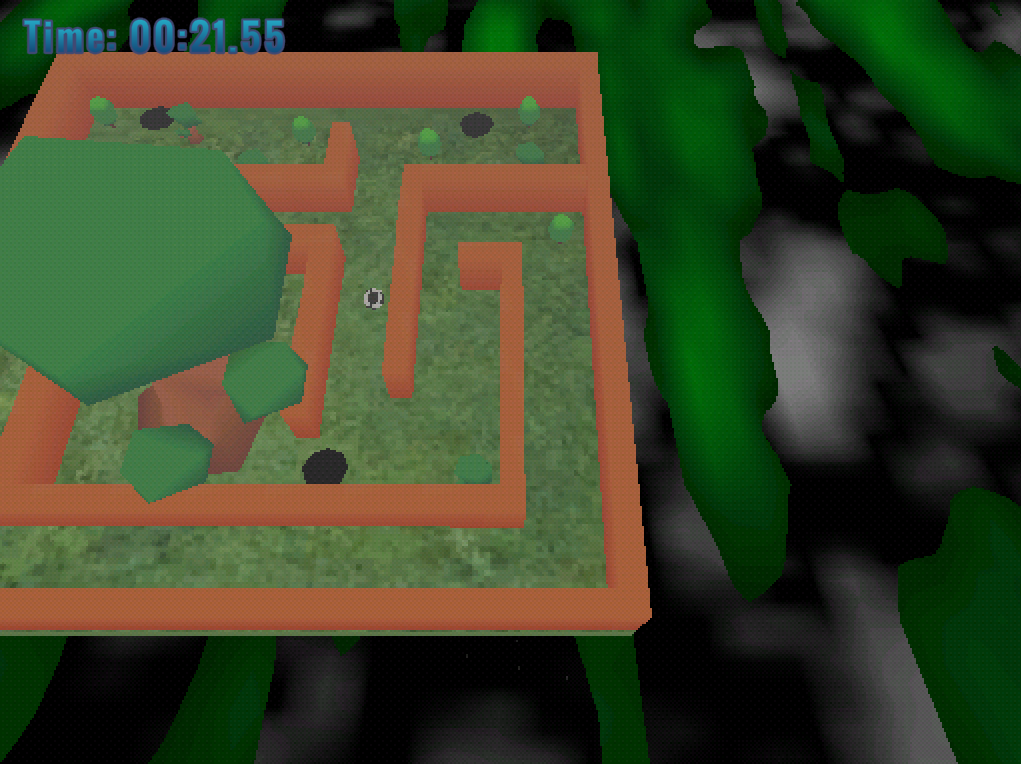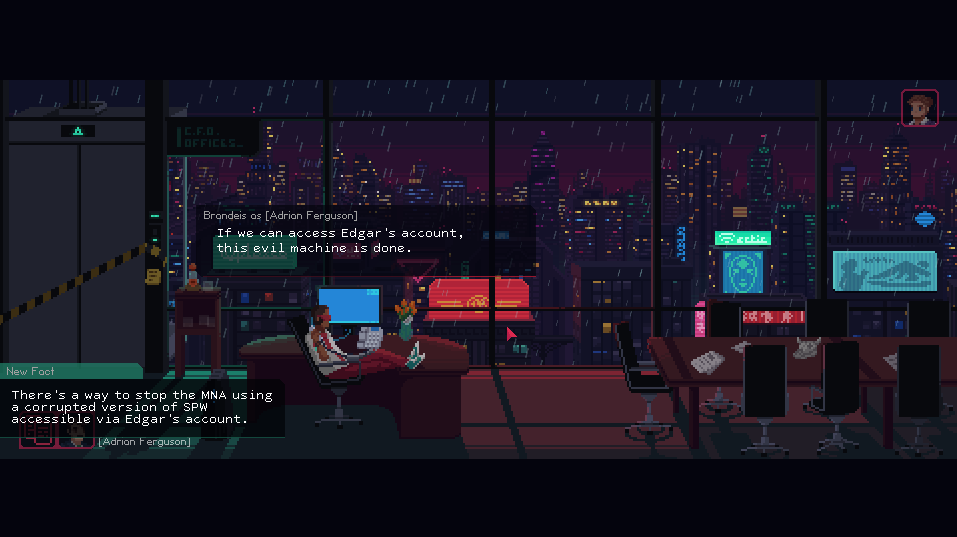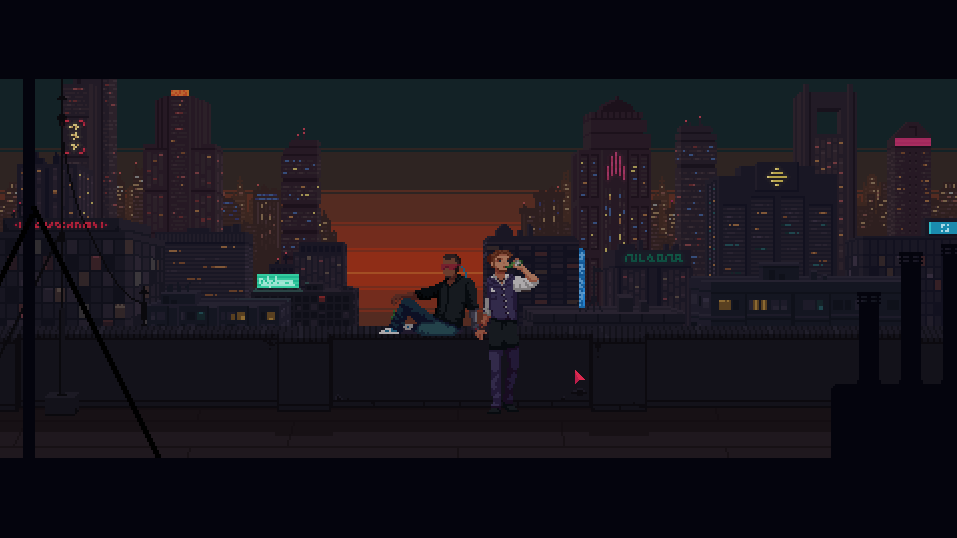From the first para of your description this sounds like Mutazione if someone pulled its fangs (to be clear, I mean this as a negative)
this is the game by my former TA at USC for multiple semesters (her name is Michelle). she was super nice and friendly and my best TA i ever had. i kinda didn’t want to play this game because i felt like it was just going to bum me out. i’m upset at the way USC would just pick students to make their pet projects and put them through the ringer and try elevate them to commercial games before they even graduated. these are undergrad students, mind you - like in their early 20’s. and everyone’s trying to be all businessy like “we’re the next big indie studio” because that’s what you’re supposed to do. i don’t think games by undergrads should be treated like this.
i dunno, esp the culture of indie stuff in LA feels very centered around this idea of studio pry cuz the proximity of things like Annapurna. in the case of this game the bugs are an obvious result of people who are not ready to make that scale and scope of game that they’re being pushed to make. and i worry about the amount of people who are very talented burning out before they really have a chance to learn those lessons.
it seems like the game is not bad though, so that’s good.
but i also think it’s not done a great service because it’s also published by White Thorn Digital, which is run by a guy who i have blocked on twitter because he’d get extremely aggressive in the mentions of anyone who was critical of the whole “Wholesome Games” thing since that’s what his publisher has thrown all their cards in. when i got annoyed by him being aggressive with other people i got into an argument where he called me “anti-feminist” for criticizing wholesome games as a concept and calling it a conservative artistic trend basically and would say “i’ve worked with many queer people and poc” as basically a shield to any criticism for his behavior. lmao. anyway, i don’t feel great having people like that functioning as publishers for people i like. and Whitethorn has really gone all in on publishing a bunch of these “Wholesome Games” in a way that feels like it’s setting up a lot of people for failure. esp when so many of these games are coming out of students and young people in similar situations like Michelle who are very young.
but yeah, i just feel like this trend of younger developers basically being asked to make a polished commercial thing that is relatively successful and gets some promotion right from the outset is real bad. it’s kind of emblematic of things moving towards the whole Roblox-style labor model.
oh BTW thanks for finally playing Salad Fields!! one of the people who made this made Mibbibli’s Quest which got some attention awhile back, but this one is not very known. anyway this designer/duo deserves way more love!!
So cards on the table time: this topic is likely gonna suffer a bit for the next little while as for the immediate future I’m looking at free time less like “gaming time” and more like “Elden Ring time”, so expect short games and short write-ups don’t hate me I’m only human, a human with a giant soft spot for From games. Basically, adjust your low expectations even lower~
10 Flights of Ballooning
This is basically ten different takes on the Balloon Trip mode from Balloon Fight, the early NES game (although by my count it was only nine). I mostly gave it a shot as the dev behind this made the neat puzzle platformer Dee Dum that was in the original giant bundle and I was curious if he could mine any gold out of this somewhat odd concept.
For those that never played the original (which one of these is basically a straight knock-off of sans adjustments) you press the action button to flap your arms which either slows your descent or increases your ascent. You have to grab balloons to increase your score while avoiding the stars that will either harm you or pop your balloon while (not automatically) scrolling sideways. In terms of early 8-bit games it is pretty neat, not a ton of variety but the mechanics while simple have just enough technique to them to make it satisfying to play for a few sessions.
Most of the variants… basically make the game worse. One makes things trippy whenever you pop a balloon, one has a SMB3-esque angry sun chase you around, one has the screen gradually get dimmer until popping a balloon brightens things up again, that sort of thing. It is basically an argument in favor of the original design as it shows how altering bits of it detracts from the overall experience.
Then there is that one variant that is completely different and the reason I’m bothering to write it up at all.
Called Shadow of the Balloon, it is a straight up Shadow of the Colossus fan game/parody made out of Balloon Fight. The thing is while it is obviously a joke it comes disturbingly close to being sort of brilliant?
The camera zooms out as the scale of everything is vastly larger and you are placed in an openish world. The addition of the stamina meter/circle dramatically alters the experience as each flap drains it a bit and while it does slowly refill at all times it is very easy to run out and be in trouble. At times you will have to fly decent distances and be precise enough to land on a tiny platform, other times you’ll be constrained to narrow pathways through killer stars that require you to carefully make your way through a maze/obstacle course to reach the colossus-sized balloons. When you reach one of the five a bit of music ripped straight from a SOTC battle will play, and when you pop it a familiar somber tune will begin as the black tendrils make their way towards you.
I ran out of lives before I could get the 5th one so I don’t know how it ends, it was such an unexpected and unexpectedly good experience I let it remain as such.
So it’s definitely a mixed bag. Most of them are at best mild curiosities, none preferable to just playing the actual game it is riffing on. Shadow of the Balloon though, rough around the edges and as on the nose as it is, actually succeeded in taking the base mechanics and transposing them into a different setting in such a way that it was legitimately transformative, it earns a full tip of the cap from me.
Midnight Scenes Ep.1: The Highway
The Midnight Scenes series are a bunch of bite-sized point & click adventure games that are clearly leaning on the likes of the original Twilight Zone for inspiration. This is most immediately apparent with the title screen against a starry night sky cutting to a short text intro to set the scene, in this particular case a young woman driving at night along a deserted road, before cutting to a black screen presenting the title of tonight’s episode. Then the game proper begins with fairly good quality pixel art that clearly places the setting as sometime in the 50s/60s, with poor Claire’s journey halted by a downed power line and her being forced to check a nearby home for assistance where surely nothing will go wrong or be creepy.
The game is about ten minutes long and the puzzles aren’t particularly complicated (although to be fair are well constructed), so the game has to live or die on the atmosphere and story. Fortunately it nails said atmosphere, suitably creepy in a way that feels appropriate to its inspiration albeit with a little bit more blood than was likely allowed back then. The story is about what you’d get if episode of Twilight Zone were 15 minutes long, basically only able to hit a few notes but they are the right ones.
For a ten minute point & click adventure game it’s about all one could reasonably ask for. The creator of it has released a couple more episodes that each double the length of the prior one so I look forward to eventually seeing what kind of story they are capable of telling with a bit more room to breathe, but for now this is a well crafted intro to what they are going for.
Room Explorer 2010: DELUXE LOVER’S PAQUE
This is basically a ten minute long digital joke (I was not lying about sticking to the very short games for the next little bit) and that is a good length for an experience like that. In Room Explorer 2010 you basically have a few things in a MS PAINT looking room that you can click on at which point a couple very short form things happen, and when you click on the desk you trigger a slightly more extended bit and then the game is done.
With a ten minute game I am generally not looking for a truly great/fully realized game, I either hope for a quick taste of something that could be refined/expanded into something more (see last week’s game) or something novel/unusual enough that may not work long term but holds up for the short time requirement. Room Explorer 2010 is aiming for that latter experience and I think it manages to just clear that bar. When you click on the plant you control a spider on a leaf except rather than give you WASD controls it goes with the intentionally funky HJKL, it’s sort of on that frequency. That’s not much, but it also only requires you to do so for maybe 10 seconds before you hit the punchline and you are on to the next thing (if you click the plant again afterwards you are rewarded with maybe the best joke in the game).
That doesn’t sound remarkable, and it isn’t. You do some things to see what happens next, they are all a bit odd but rarely impressively so, they all go by quick, you get to the final bit and the closest the game comes to a point and you are done. Over the past couple years I’ve played a bunch of small indie games and often they are like this. I know some of you have played a bunch of them as well and likely know the type. Some will play something like this, consider it stupid and a waste of ten minutes and never think about it again. I like to see things even if they are just kinda there (as long as the time ask isn’t too steep), will play something like this for ten minutes and go “neat”, and also likely never think about it again. Both reactions are probably fair enough, pick whichever one is more likely to be your own and that’s my review of the game.
Oh yeah, this is the deluxe pack version which means it comes with an extra folder with all the graphics and the script, plus some in-development images and a brief text document for each bit explaining why they did what they did for each little thing. It’s very minor and not a full break down but it does give an interesting little peak behind how this came to be what it was. I rarely read things like that so I found it to be neat.
NEO-PROGRAMS
Neo-programs is a ten minute long visual novel/adventure game mash-up about AI and viruses and…
…you know what, I can’t write about another 10 minute long game I have no actual thoughts about (the game is honestly mediocre). I gotta at least try a bit more this week…
Willful
Willful is at least ten times longer than ten minutes long, perhaps even fifteen times longer! It is a platformer that claims to take some inspiration from classic Mega Man and Metroid games, and I see a dash of puzzle platformer inspiration at points as well. That said those are classics for a reason while this…
…This has the feeling of being a student or “early” project. It’s not bad, there was no point where I was going “this isn’t fun at all” and was forcing myself to play through it. Granted I am a soft touch for throwback games of this sort and the utter lack of difficulty meant there was very little resistance holding me back, but it also struck me early on that it didn’t feel like there was a lot of level design present. That does pick up a bit later on but even then there are stretches that feel very straightforwardly moving through hallways. The controls are mostly fine and responsive with the exception of the dash move that is triggered when you press jump a second time mid-air (if there was a double jump this is how you’d do it). It often seems to register the dash instead of the initial jump if you press the button even near the edge of a platform which is often annoying if not deadly due to the game mostly lacking death pits.
What makes it feel like a student/early project and hence what makes it slightly more interesting to me is that the dev clearly has an awareness of certain concepts in play in games like this but not the ideal or at the very least typical way they are executed. Enemies stay dead throughout the entire area once killed but will also follow you from adjacent screens, which is normally no big deal but there is one place where tiny little bugs pop out of holes in the ground every so often and fly at you. The thing is this level is sort of layered atop itself (go left to right, enter a door that takes you up a screen’s height and then go back right to left) so on the second layer making your way back all those little bugs end up flying back up from the screen below and causing havoc. It is messy and a bit annoying but it is also something most games of this type wouldn’t let occur.
There are other examples of the game being just a bit off from typical. One of the last areas takes place in space so instead of jumping you can float freely in a big scrolling open space, except aside from some unmoving asteroids and a few enemies the only thing to do is approach individual room-type areas here where once you go through the door into them you are back to the normal jumping and physics. At the start of the final stretch of the game there is a hallway with a few jumps above a glowing floor and ceiling, and if you miss a jump and fall into it you emerge from the ceiling a la a warp gate. This mechanic exists literally only within this transitional hallway. You get a message immediately after about how you can get to the final boss if you can make it through the upcoming maze; what follows is a linear area that just has you re-fighting all the bosses you faced before. Hence it perhaps unintentionally does a decent job keeping you on your toes.
All that said the overall structure is fairly standard. There are ten stages that open up as you find golden carrots (eight per stage) that often have doors you need to find switches to open up, these stages are open-ish in that there are probably a few different paths to take but generally speaking you’ll have to take all of them at some point. Some stages have bosses but they are generally more exploratory, you don’t need to find all the carrots but it seemed to be a good idea so I did so. Oddly one of the carrots in the second or third stage can only be gotten once you find a key in one of the late stages and come back, which also gets you a weapon that is needed to actually reach/damage the final (and I guess final true) boss so if you don’t get it you are locked into a bad ending.
The gameplay is mostly standard 2d action platforming with some shooting at enemies, it is also very easy (I think I got through the end game boss rush with only taking a single hit). It does often add in some decent mechanical wrinkles such as the Mega Man-esque blocks that flash in and out of existence in a certain pattern or blocks that move across the screen once you shoot a starting switch, they do break up the monotony but again the game itself never demands much of you so these mechanics always remain rather basic. Funnily enough the game lifted the dying system from Fromsoft where if you die you can make your way back to where you did so and pick up all the money you dropped (there is a shop where you can buy weapon upgrades, carrots and some other stuff I never figured out) except that it also seems to be slowly floating back towards you as well, I thought that was a cute touch.
Basically Willful is pleasant if slight. Took me maybe a bit more than two hours to check out all three endings (game keeps a save ten minutes tops from the end so you can go back and get them), mechanically and design-wise it is hard to argue that there is really much there but if you just want to jump and shoot at things in a low difficulty setting (while playing as a bunny) it certainly scratches that itch for a bit. Add in a bonus point if seeing a dev not quite having everything quite figured out strikes you as interesting as opposed to annoying.
Oh yeah it does the end credits deal of showing and naming every thing you’ve come across in the game which without fail always makes me smile.
La Maleta
La Maleta is a short narrative game (a full twenty minutes this time!) that takes a look at the social/political situation in the Canary Islands during the 1980s. It turns out that’s one of those situations I didn’t even know I didn’t know about.
The game itself is laid out like a point & click adventure game if you more or less removed anything resembling a puzzle from it. There is one bit at the end of the game’s first act that if you squint could maybe resemble a puzzle but that’s about it as far as what one would traditionally consider “game” elements in La Maleta. Generally you click on things to get a description of them or on people to initiate some dialogue, that’s pretty much the entirety of what you do.
The story is about a young man going to school while living with his mother and always absent father (who is away working a low paying yet very dangerous job). NATO has set its eyes on the island as a swell place to put a military base and store all sorts of weapons which a significant portion of the islands’s population isn’t exactly pleased with, as noted by the protagonist and the magazines he receives over time. He grows to feel a bit disillusioned with his prospects if he stays here, hence the focus on “la maleta” (the suitcase). He takes a job waiting tables which sees him stuck serving the “visiting” Europeans who seem to be taking over and quite often buying out large portions of the island which leads to him openly questioning whose islands these actually are any more.
The game is originally in Spanish but comes with an included English translation, although the occasional voice work (mostly kept to voicing lines from the original poem La Maleta which the game is based on) remains in Spanish only. On one hand the game is clearly amateurish, rather simplistic and limited mechanically and environmentally in what it attempts. On the other there is a clear passion regarding the topic at hand it is addressing that for those who ive there is not limited to the past but still affects them to this very day, a passion that by the end becomes fury. As a game I’ll likely forget about it soon, but as a lesson about something I had not previously known (the west messes up so many places I never even considered) and the passion from those who it affects it will stick with me quite a bit longer.
Bonus: Rats in a Cage demo
Played a demo for this upcoming puzzle game in the Steam Next Fest as the dev was looking for feedback. This Baba is You looking game (less squiggly in motion though) is basically an exercise in manipulating basic NPC AI. The story is too much to get into, basically it takes place in a theoretical business setting (the rat race, etc.) but your main concern is opening the path to the exit and getting to it. The main issue is that other rats are often in the way of either the switches or exit itself, so you need to manage their movements in order to clear or at least not block the path.
The main way this is done in the first floor (the only one available in the demo) is by using coffee to lure them. If they have a clear path (no door, email or you yourself in between it and them) they will move in real time towards the closest available one. This sometimes gives things a bit of a timing element but it is more about making use of the options available to you to control when they make a move for said cup. As a mechanic it does seem to have potential, I am not certain this game will come together into something noteworthy in terms of exploring said mechanic but it at least has the chance to.
The game does the thing where some “higher force” monitors and frequently mocks you, although I must say it often comes across as more spiteful than I’d care for. It’s less winking at you and more directly calling you a fucking idiot, and I’m not sure I could put up with a full game’s worth of that. It’s seemingly mocking corporate structure and how little they care for you, but unpleasant is unpleasant. On the positive side the dev has quickly responded to feedback and updated the demo based on it already (instant restart, moves smoother, gets to the game itself quicker) which is always a good sign.
Betrayal at Club Low (demo)
This one is actually somewhat known, but I’ve wanted to try its demo for a while now so hey, screw it. Betrayal at Club Low is a slightly surreal adventure game about having to break/sneak into a nightclub and rescue another agent who is possibly trapped in there. This makes it sound like it is setting up to be a stealth game, instead it decides to be a fairly zany dice-rolling adventure full of options. Many of those options seem to be for the opportunity to screw up, but we’ll get to that.
You have seven different stats each represented by a different die, with the money you gain/find around being used to purchase better numbers. All of them start with three 1s and three 2s, and you can choose to focus all your energy on specializing on one specific attribute or being a bit more well-rounded (based on a few trips through the demo focusing on just one might not be ideal). The demo itself only lasts until you break in and make it to the main dance floor, but doing that alone reveals the variety of paths open to you. There is the direct path with the front door (which requires dealing with the line and the bouncer), a back door with a single sleeping guard nearby, and a fire escape you can almost reach the ladder for. There are generally at least three options for dealing with any given situation, each one focused on a different stat of yours and different strength “obstacle” die (ex. going physical against the bouncer is harder than other options). You roll all your dice and they roll all of theirs and…
…Oh, right, the other dice. Your main one is the pizza die (or dice, you seemingly can get more) you prepare at various pizza ovens you come across. These at least in the demo don’t have numbers on them, instead you select from a variety of ingredients to lay out on each side that do things such as up your health or nerve (if either hits zero it’s game over) or win you some extra cash. On top of these there are various other “conditions” dice, basically every time you win or lose a specific dice battle you gain one or more conditions that last until your next roll. These conditions can be good or bad but are always short term yet are impactful enough to sway things significantly (in the demo I’ve seen ones with +2s and -2s on top of various other health and nerve impacts). It can mean taking an intentional hit on another follow-up roll/encounter to try and rid oneself of a negative die or using a good one to take a shot at an otherwise high risk obstacle, it is really up to you.
The good thing is that the game leans on these rolls/encounters not being of life and death importance. Yes you can be drained of health/nerve and you need to keep that in mind but as you pick your own battles you can go do some encounters where the risk to either of those is low while the chance of gaining some of either back is high even if you lose (remember, you can design your own pizza dice and make them more likely to boost what you need, or just get you some more cash). There are encounters where even though you have a low chance of succeeding the penalty for losing is just an iffy condition for the next roll which means you can just spam the same battle repeatedly if you want until you luck out. Add in that the game let’s you re-roll any give die of your up to two times for free in each encounter (this varies with the difficulty level) and the game basically pushes you to take chances and go for things.
The end result is a pretty open if self-contained, fairly creative little dice rolling adventure. The demo cuts off before the story gets too involved but it seems more like an excuse to set the hijinks in motion than anything else. Even early on the amount of options available to you are impressive, and while I’m not sure it’d be worth trying to track down each of the 11 endings I can definitely see the appeal in going through the supposed few hours it takes to play through a few times just to see all the various ways you can interact with this space and how it may change/unfold differently based on the different approaches you have. The fact that I played through the demo three times is a testament to how much enjoyment I was getting out of it.
New Spirits
…Won’t be the game I discuss this week. It’s a spooky walking sim with a camera game that seemed appropriate for Halloween times but sadly it runs terribly on my PC. This may have been livable (I can deal with a frame rate of like 5 or so when I really want to) but the game also lacks any kind of intro/manual/set-up so I honestly have no idea if I’m supposed to be doing something. I did like how the game would randomly warp me between different areas every so often without warning and occasionally figures would pop up before disappearing, but sadly I had to skip out on this after 15-20 minutes of scratching my head. Might actually be decent, dug the staticy with floating light orbs aesthetic enough to mention the game long enough to justify sneaking a screenshot in here, but y’all are sorta on your own on this one.
Which leads to the second game attempt of the week…
Eyewear Cleaner 2077
Parodic name aside this is a serious twine-based bit of interactive fiction in a cyberpunk future. You are someone whose job involves cleaning those futuristic bits of eyewear, a job even worse than it seems as you have to insert an implant that projects a holographic boss at all times and fines you whenever you even think about something not work related while on the clock. That may have been the most horrific notion I’ve come across in a game in ages.
Beyond that it is a fairly basic tale of someone ground-level in a future dystopia wandering into the orbit of some other more “relevant” figures in the midst of the less than subtle day to day horrors of this world. The choices seem fine, I wish the writing was a touch better given it is such a text-focused experience but it’s certainly better than anything I could write (I submit this entire topic as proof). None of that is what I will remember about this game, what I will remember are two utterly minor things that just leapt out at me and made me wish I could submit follow-up questions to the dev in order to figure out exactly the hows and whys of them.
This is the first and simpler of the two. This lady pops up a few times and the game always stops to mention her striking red dress; that dress is clearly blue. That said most of the character portraits in the game (but not all) are blue shaded so I am left wondering if my character is wearing a never-mentioned visor that makes everything appear blue and this is the subtle way the game relays this info, or if this is just a baffling oversight (same person did the text and illustrations I believe). Either way I am likely overthinking it.
The second one… okay, a major plot point in the game is that there is a vigilante named Lowlife who is attacking/stealing from drug companies, likely in a Robin Hood-esque manner to give to those who can’t afford them. This is also a cyberpunk tale where things have futuristic names, so they go with the very cyberpunk sounding drug name of Synthroid. Syn for synthetic, lots of drug names end in -roid which also sounds vaguely futuristic (like android). It’s also the name of a real drug that is highly prescribed and came out in like the 1950s and… I honestly have no idea if the writer is aware of this. Maybe they were and they picked it because it has that futuristic sounding name, or maybe they had no idea and happened to come up with an already existing name.
The problem is (lengthy digression incoming) Synthroid’s been generic for a while now and while it isn’t the cheapest prescription drug in the world it is definitely closer to the affordable end (store acquisition cost for a bottle of a thousand is probably about a couple hundred bucks). A few people are stuck using the name brand which is markedly more expensive and would be more worth committing crimes over, but the vast majority aren’t. While in the future drug prices could become truly absurd I don’t think this particular drug is ever gonna be near the worst of the bunch in that regard.
Neither of these individual points really matters much in terms of the story told, again they are both small details paid very little mind. The larger point to me is that it shows how sometimes the most random details get lodged in a player’s/viewer’s mind and end up overshadowing the rest of the experience. The details of the story will likely fade from my memory before long but I wouldn’t be surprised if I end up rambling about that Synthroid bit to someone a decade from now. I doubt this is what the creator would have expected or wanted but we all likely take something away something from most games we play and quite often it is something incredibly random, and this notion gets to be one of the things I take away from this.
Strobophagia | Rave Horror
Okay, gonna be just direct here, I played this game during the week (took probably a bit under 2 hours) but I generally write these up late in the week and then give it a quick once over on the weekend before adding some screenshots and posting it. The thing is as I alluded to elsewhere my sis got married this weekend and that ate up a ton of my free time (it went well FWIW, although I wouldn’t have bothered to wear the suit if I knew my new brother-in-law’s family was mostly bikers) but pushing the horror game write-up beyond Halloween feels dumb, so we’re just gonna toss out a few bullet points and consider that good enough; we’ll try to be better next week.
Strobophagia is one of those mostly walking around horror games that adds some minor puzzle elements and a brief stealth element near the end.
Strobophagia stands out because of the aesthetic, rave-inspired with lots of blacklight-esque effects and such. It looks kinda neat to be a part of this creepy rave in the middle of the forest even if the middle part with a lot of flashing lights tanked the framerate on my aging PC.
Strobophagia’s story is fairly light for the most of the experience (it’s a rave in the middle of the forest in a horror game) only to have the most (thankfully mostly optional) massive lore dump right before the ending.
No one actually talks in the game, all communications are via people directly in front of you sending texts. Avoids having to voice anything or break immersion, makes me worry about the future of conversation in the world though.
I don’t know that I ever found the game particularly scary or startling, which would probably be an issue for some.
Mechanically there’s not really a ton there worth remarking on, some interesting ideas with how heavily the phone is featured at times but they are only developed so far. I never figured out how to put said phone away though.
The game mostly works as a mood/aesthetics piece and for the most part it delivers as such. Most horror games don’t bother being this colorful, I dug how over the top everyone’s outfit/design was, as a setting I dug it. I don’t think any other part of it will wow anyone (I’ve played both better and worse examples of this flavor of horror game) but in this way it stands out and is worth at least looking at some screenshots of. At least I hope it is, kinda leaning on said screenshots to pad this whole thing out >_>
Eponymous
Eponymous got to be this week’s random game for a simple reason: when I checked itch on Halloween it was a free giveaway for that day only. That raised the specter that it would be appropriate for such a spooky day and… it has some light horror elements but it wasn’t really at all. I say that but the thing is I’m not exactly sure what it was going for at all?
Best to start at the beginning. Eponymous (In Which a Work Is Known by Its Reading) is a walking sim, one in which you start in a room where a voice seemingly over a PA system lets you know that you are linked in, then you are given the ability to walk and basically told to go wander around and find things to increase your mobility. The place initially seems very office building-esque via Minecraft, although as you gain access to more of it it does get a bit more surreal.
It is somewhat unusual mechanically as it is a walking sim crossed with a metrovania. You walk, then gain the ability to jump, dash, double jump and various other abilities that each allow you to press further into this space at a few different points. It seems like an odd mash-up but it’s actually where the game is at its strongest, everything is rather small-scale so you never have to backtrack too far and things can double back over themselves without much effort. There isn’t a ton to see sans a few specific things, but the layout is designed well enough that just interacting with it and following the paths it nudges you along is rewarding enough for the 40ish minutes it takes (there is also no combat, which was probably a wise choice in this instance). The other thing prodding one forward is seeing exactly where the voice overs and set-up is leading (plus the few slightly spooky teases) and, well…
The way the voice overs are presented make them seem like they are important. I’d go as far as to say that it feels like whatever they are driving at is the point of the game, with the mechanical aspects just being a means to an end. The issue is… it’s a huge miss. There are times when after playing a game I go “I’m not exactly sure what this is driving at/might be a bit over my head but that’s at least somewhat on me” but I don’t feel like that about Eponymous. I feel like if it had a definite idea it was going for it just didn’t get there, and what they did do in this regard is both vague and sorta never adds up to anything.
There is a clue in the end credits where it recommends a few things as “further reading”, one of them being House of Leaves. If you want no aspect of said book spoiled just skip the next two paragraphs. The reference to House of Leaves is definitely… let’s say loaded (FWIW I think House of Leaves is fine), but to me if you are gonna point to that with regards to your game said game would require either some formal ingenuity or a focus on impossible spaces. While I said a walking sim metrovania is a bit unusual I wouldn’t use the word “ingenuity” with regards to it. The impossible space part is interesting though as it points to the differences the medium of choice makes with regards to this. To be blunt, video game spaces on average are much more impossible than ones we would see in reality or in most films/books for various mechanical/design/“we’ve always done it that way” reasons so what would be unusual in reality would not seem so in the context of gaming. If the space in Eponymous existed in real life the amount of side paths or ducking into a crawlspace to find a big underground section below a facility would stick out as something that nominally should not be. In a video game though it’s fairly standard.
This means that if you want to portray an impossible space in a video game you need to go much further, you basically either need to go completely impossible such as in Antichamber or design the heck out of a limited space so that the borders and possibilities are intentionally blurry. The latter is possible but difficult especially in the context of a metrovania as in many ways they are often built around exhausting possibilities. I think this is where thematically Eponymous missed the mark as in terms of construction it is a well-executed metrovania space but not a particularly unusual one in any way, and if doesn’t even feel unusual it won’t ever feel impossible. I will give credit for the store page clearly saying the game takes 10 minutes to complete when it is clearly closer to 40 as a gambit to try and hammer home the “hmm, maybe I have wandered off track and things have gone wrong” feeling even if it doesn’t quite land. TBF it also doesn’t help that when the game changes the wall textures to make it seem different from the standard facility appearance it often has it does so by lifting the aesthetics from some of the most well known and hence ripped off properties out there. One path leads to Alien textures and another drops you literally into the red room.
Ultimately I’m left feeling that Eponymous failed in its intended goal of whatever mood or point it was trying to make in a fairly definitive way, but the aforementioned “means to an end” structure and mechanics and exploration actually deliver. Because of various bundles and random games I’ve played a bunch of small scale metrovanias (think 20 minutes to a couple hours in length) and these often avoid the issues that can haunt their full sized brethren. Much less backtracking, less of a chance of forgetting where you last saw that thing you can now access, pacing is quicker and the level design is often tighter. Eponymous is a fun place to poke around and watch unfold as a space for 40ish minutes and I choose to remember that which it did well as opposed to what it did not.
Find Me
Find Me is a vaguely Limbo-looking (read: gray scale) 2d puzzle platformer mostly lacking the puzzle part. Taking place shortly after the lady you play as doesn’t look up from her phone in time to not get hit by a car, you control her spirit through basic 2d platformer stages where you must avoid any source of light as touching any of it for more than a second will cause you to poof.
This is actually a pretty neat mechanical idea for a 2d platformer, it does a good job of having the threats more seamlessly blend into the environment (a flickering street light on a street makes a ton of sense) while shifting things to a more timing-based challenge. The problem is that… execution-wise it all feels very middling. It’s not one of those platformers where moving and jumping around is pleasant on its own, which is why I guess it describes itself as a puzzle platformer. The thing is there really isn’t much that I would describe as a puzzle (you see a switch, hit it and a light in your way turns off) so it feels like the game is missing a hook somewhere. The graphics aren’t bad but aren’t that striking, it controls okay, the level design makes no real mistakes and at times offers a couple different paths to take but I can’t see anyone remembering any of it once they are past it. It… basically exists.
I feel bad as I’ve written more about worse games and this one isn’t really bad, it’s just that aside from a neat initial concept it’s rather unremarkable. It apparently won a 2017 Girls Makes Games thing that was judged by Tim Shafer and the former wrestler AJ Lee (among others) and that’s an odd enough pair that I’d love to know their shared judging criteria.
Hot Heat Reset (demo)
Since I didn’t really have much to say about that game I’ll mention this upcoming game’s demo I also tried this week. Hot Heat Reset is described as a maze action game (I guess like Pac-Man) that has a “press one of four directions and go flying in that direction until you hit something solid” control scheme. You basically have to grab every tiny blue collectible thing in a stage, which opens the exit of said maze. It’s a fairly standard concept but it feels a bit different so far in the demo.
I think the biggest thing that sticks out is that it feels very quick. You fly across the stage so fast that if your fingers are fast enough you can blaze through a series of turns in about a second flat. The game only requires you to do so once or twice in the demo (or perhaps I was missing an easier path) but even if you don’t have to push the pace and instead take your time it gives the game a very snappy dynamic feel. It’s probably best to not go too fast too soon though as despite describing itself as a maze action game it is much more puzzle adjacent as you sometimes need to figure out the right series of moves to make to grab a certain blue thing or make your way into a given pathway.
It also has a button that let’s you place a block in any adjacent square that isn’t a wall or block that also happens to explode a second later and will kill you if you are still nearby. Even with the presence of a tutorial the demo doesn’t really put you in any situations where this seemed necessary or even helpful. This may simply be the consequence of the demo being the first 10 or so stages but I couldn’t really get a feel for how this mechanic would play out in the game proper. These opening stages do have existing blocks that are set to explode a second after you touch them that do a fine job of spurring you forward.
Anyways as a demo I can’t say for sure that the final game will be good or not, but at the very least it feels good. The graphics are simplish but very clean and striking, the controls are quick and responsive, and while what is included feels a bit basic (again, first 10 levels) I can see how it could potentially develop into something rather swell. I’m just gonna end by including the store page video as it gives a better feel for how quick it can play than anything I could write.
The Fantaballous Tilt
The Fantaballous Tilt (solid name BTW) is basically a video game version of those wooden labyrinth games. I know a lot of marble games are vaguely inspired by those, but this one even with the more videogamey aspects that pop up feels directly connected to them.
I am gonna stop here to just be completely honest. Reading the game’s itch page the lady who made this seemingly did so because they wanted to try making a more physics-based game, and the only reason I played it is because she went and contributed it to a big charity bundle in order to help out with a good cause. Those are a poor set of reasons to get criticized for, but really the only thing I can honestly say about this game is that it’s not very good.
I can see why they wanted to work on their game physics as they basically only had a beginner’s level grasp of them at the time this game was made, and unfortunately this is just about the worst type of game to have that happen with. You can only turn the maze in 90 degree increments and when you do so the ball pauses in space while the level turns and all momentum it had beforehand vanishes as it begins moving in a different direction. It often hops backwards a bit too immediately after the directional change which is odd and can make taking corners oddly difficult at times. The ball also sometimes falls through the walls out of the stage requiring a restart.
The problem I’ve discovered with going with truly random selections (particularly on weeks where I can only get around to a single one) is that some simply just don’t work, and this game is sadly one of them. I hope the experience the dev gained making this will help her in the future and that the game was at least fulfilling for her to put together, but there’s no real reason I can come up with for others play it.
The fake haunted Playstation logo that pops up when you start it is pretty great though.
The Red Strings Club
Heh, after last week I was hoping for something a bit less… hobbyist and the rando picks a game published by Devolver already known to some here. That’s a bit of an overcorrection but hey, that’s random for you (legit BTW, was the first game the randomizer selected).
The Red Strings Club is a narrative not-quite point & click adventure game that takes place in a cyberpunk somewhat dystopian future. The game starts with a conversation between two men in a bar: the bartender an information broker without any cybernetic implants and the ability to manipulated people’s emotional states with his drinks, and a frequent visitor and friend of the bar with connections to certain underground gangs who often partakes in various somewhat illegal hacking activities. Well actually the game tecnically starts with one of those two falling to their death out of a tall building before flashing back to said conversation, but that’s close enough. Anyways their conversation is interupted when a damaged experimental android stumbles in and in doing so alerts them to a giant corporation’s upcoming plans to improve society in a manner that could somewhat accurately be described as brainwashing.
This type of game lives or dies based on the strength of the concept and the writing supporting it, and both are fairly well handled here. There is not a shortage of cyberpunk tales out there and while The Red Strings Club does stay close to some commonly seen genre pillars it takes them is a fairly interesting direction, focused more on the emotional aspects of societal control and if they are worth blunting in the interest of the common good. There is a solid amount of choice offered to the player complete with an ongoing timeline that shows where you influenced the story to take a particular path but I am fairly certain that the story ends up taking a fairly similar path to a fairly similar ending no matter what you do, basically you have the ability to influence things but not outright change them to a massive degree. I assume the ending can be altered but only by so much.
You switch between the two main characters (and briefly as a third) and because of their different skills you generally do different things while playing as them. The bartender questions his patrons (who coincidentally are all connected to the central mystery luckily enough) in order to gain info on exactly what is going on. He augments this by mixing drinks that can shift the drinker’s mood and emotional state in certain directions. Boosting one’s pride before asking them about what they are working on, or paranoia before asking about who they work for may make them more willing to spill the beans. The other character theoretically is more of a hacker (and he does hack stuff) but playing as him one generally uses info the bartender gets you to better emulate someone in order to convince someone else to give you access to what you are looking for.
According to the store page there is also a pottery mini-game that I somehow never found/used. Oops.
The Red Strings Club is also blessed by very strong pixel work. The game is limited to only a few different locations but they are all very detailed and a pleasure to look at. Due to the nature of the game characters don’t move a ton but there are a lot of animated touches that help bring things to life, such as one characters leaning in so that another can light their cigarette for them.
So yeah, this isn’t really a week where I get to help surface an otherwise overlooked game (again it’s published by Devolver who I assume can do a much better job of that than I can) but them’s the breaks sometimes. The Red Strings Club is still a strong tale told fairly well, building up to a conclusion with some worthwhile twists and turns that fully held my attention for the 3-4 hours it asked of me.
I feel like there was an early mini-game in this that immediately annoyed me and I bailed out on it. And that is my useful contribution to the discussion~
Based on glancing at some of the discussion around the game (I went looking if there were other endings) that was likely the pottery mini-game that I missed and seemingly crossed up several people. I wonder if it was made optional at some point… no, apparently someone was complaining about it a couple days ago on the Steam forums. Screw the actual story, how many others quit the game over that yet I never even came across it is the biggest lingering mystery to me.
I really liked playing through this myself. A lot of crazy ideas, some well executed while some never really got the full effect of their potential like the drink/mood idea.
Really enjoyed my time with it, and frankly wish there was more stuff like this out there.
Glad you played it too, though seemed to have a more middling effect on you.
At least superficially, Coffee Talk and VA-11 Hall-A might have a similar thing going on.
I liked the game! Wasn’t blown away but I’d have scored it a solid 7.5/10 and I’m a rough scorer, I just often end up slipping into a neutral voice when writing about stuff.

